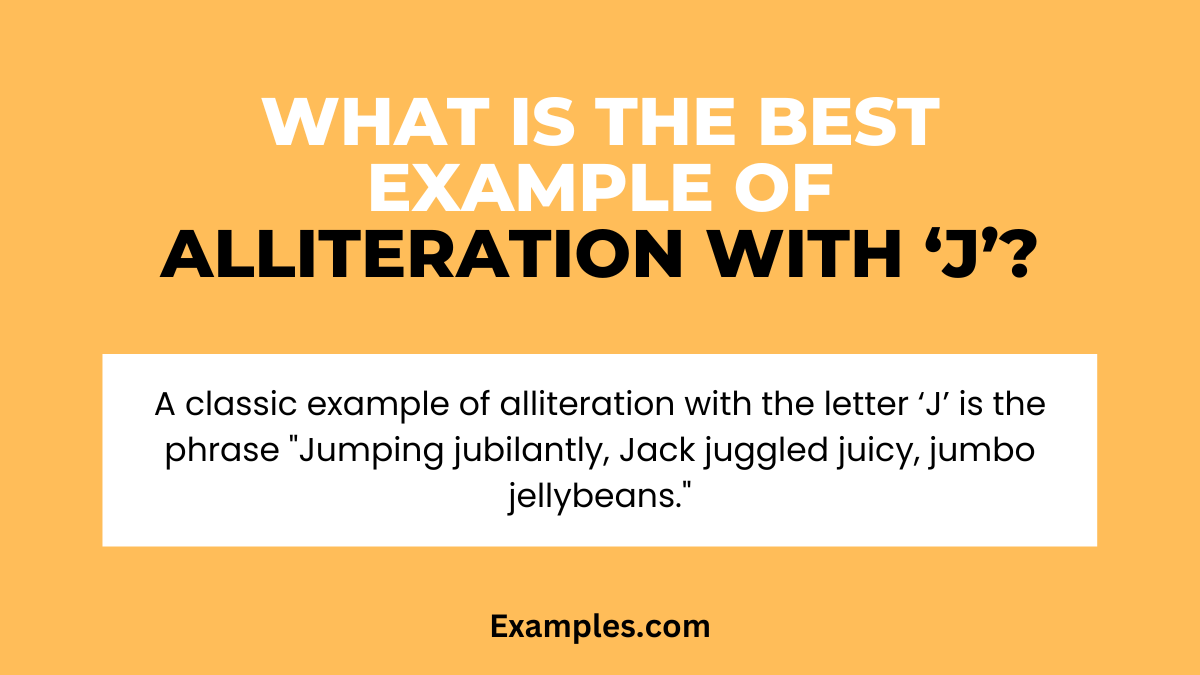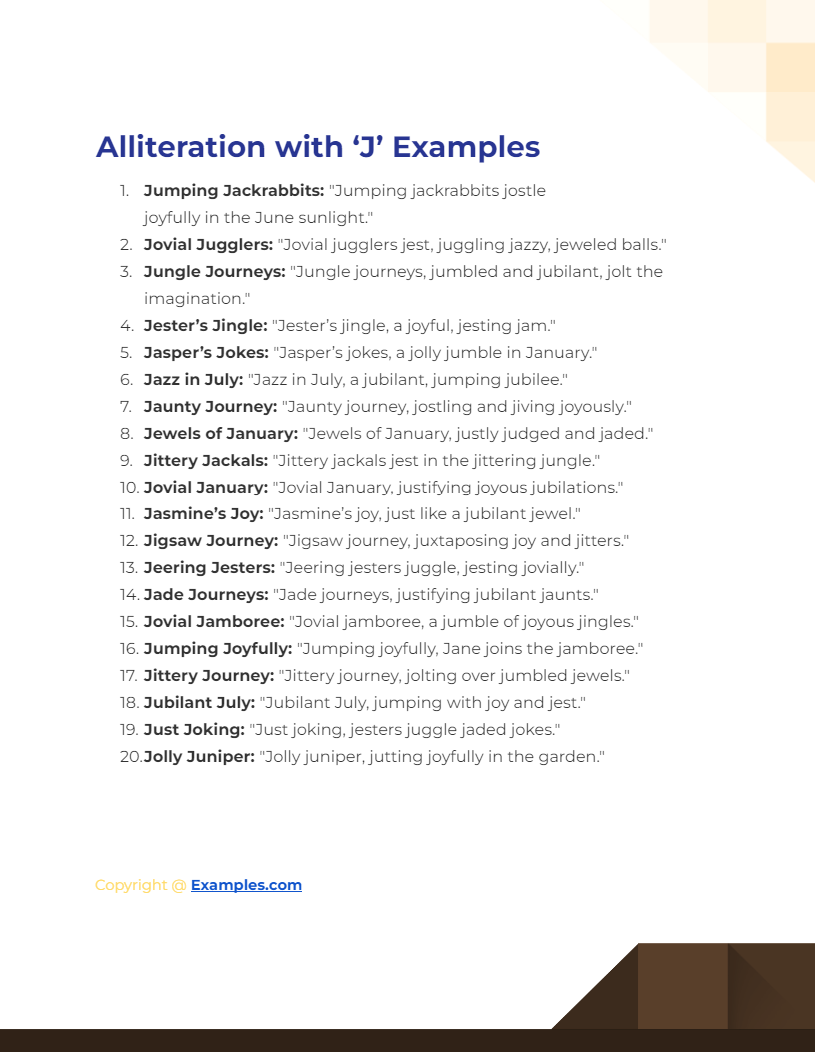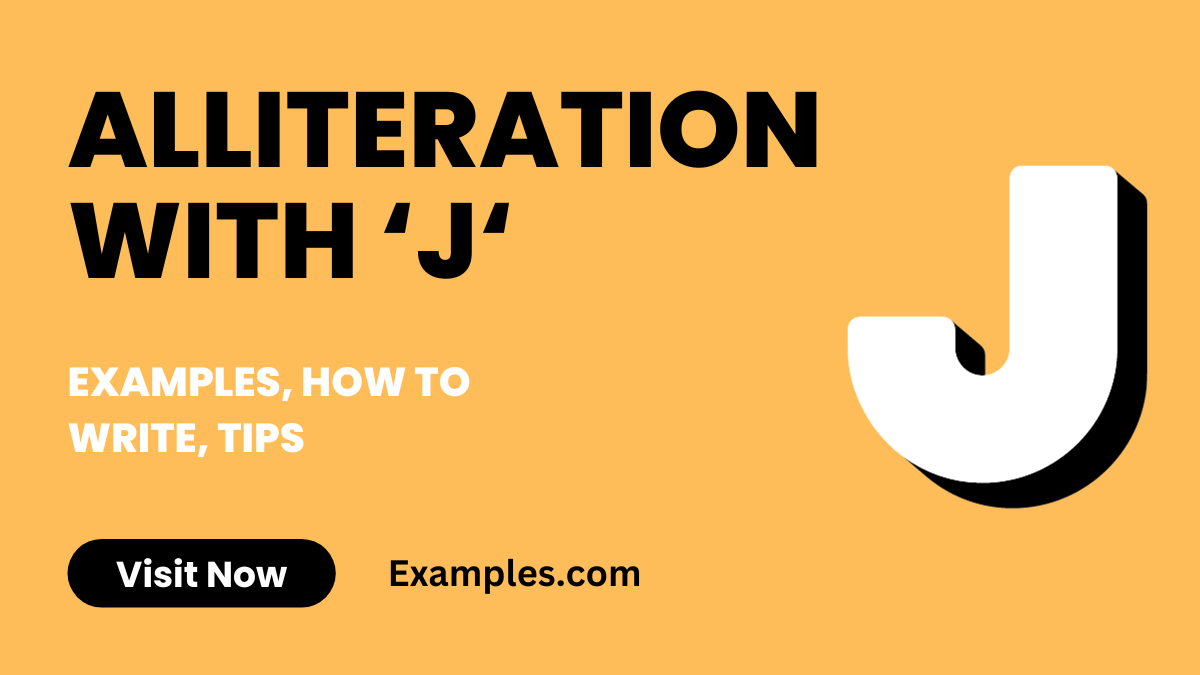Alliteration with J
Alliteration with the letter ‘J’ offers a jubilant and jazzy twist to writing. It’s a literary device where the initial consonant sound, in this case, ‘J,’ is repeated in close succession, typically at the beginning of words. This technique adds a lyrical quality to phrases, making them memorable and impactful. Writers often use ‘J’ alliterations to inject joy and rhythm into their work, whether in poetry, prose, or everyday language. Mastering alliteration with ‘J’ can jazz up your writing, adding a playful or persuasive edge that engages readers.
Download Alliteration with 'J' Examples
Download Alliteration with 'A' to 'Z' Examples
What is the Best Example of Alliteration with ‘J’?

Example: A classic example of alliteration with the letter ‘J’ is the phrase “Jumping jubilantly, Jack juggled juicy, jumbo jellybeans.”
Meaning: Alliteration is a literary device where consecutive words in a sentence or phrase begin with the same consonant sound. In the easy alliterative example “Jumping jubilantly, Jack juggled juicy, jumbo jellybeans,” the consonant ‘J’ is repeated at the beginning of several words, creating a playful and rhythmic sound pattern. This technique is often used in poetry and literature to add emphasis, rhythm, and musicality to the text. In this specific example, the repeated ‘J’ sound contributes to a lighthearted and whimsical tone, making the sentence more enjoyable and memorable.
20 Alliteration with ‘J’ Examples

Download Alliteration with 'J' Examples in PDF
Alliteration with the letter ‘J’ juxtaposes a jovial and jaunty rhythm in language, often bringing a playful or jubilant tone to the phrases. The ‘J’ sound, with its distinctive clarity, offers both easy and hard alliteration examples, suitable for various levels of linguistic skill. This type of alliteration is particularly effective in alliteration in rhymes, where the repetition of the ‘J’ sound can add a lyrical and engaging quality. Here are 20 unique examples of alliteration with ‘J’, each accompanied by a rhyme title that captures the essence of the phrase.
- Jumping Jackrabbits: “Jumping jackrabbits jostle joyfully in the June sunlight.”
- Jovial Jugglers: “Jovial jugglers jest, juggling jazzy, jeweled balls.”
- Jungle Journeys: “Jungle journeys, jumbled and jubilant, jolt the imagination.”
- Jester’s Jingle: “Jester’s jingle, a joyful, jesting jam.”
- Jasper’s Jokes: “Jasper’s jokes, a jolly jumble in January.”
- Jazz in July: “Jazz in July, a jubilant, jumping jubilee.”
- Jaunty Journey: “Jaunty journey, jostling and jiving joyously.”
- Jewels of January: “Jewels of January, justly judged and jaded.”
- Jittery Jackals: “Jittery jackals jest in the jittering jungle.”
- Jovial January: “Jovial January, justifying joyous jubilations.”
- Jasmine’s Joy: “Jasmine’s joy, just like a jubilant jewel.”
- Jigsaw Journey: “Jigsaw journey, juxtaposing joy and jitters.”
- Jeering Jesters: “Jeering jesters juggle, jesting jovially.”
- Jade Journeys: “Jade journeys, justifying jubilant jaunts.”
- Jovial Jamboree: “Jovial jamboree, a jumble of joyous jingles.”
- Jumping Joyfully: “Jumping joyfully, Jane joins the jamboree.”
- Jittery Journey: “Jittery journey, jolting over jumbled jewels.”
- Jubilant July: “Jubilant July, jumping with joy and jest.”
- Just Joking: “Just joking, jesters juggle jaded jokes.”
- Jolly Juniper: “Jolly juniper, jutting joyfully in the garden.”
Alliteration Sentence Examples with ‘J’
Alliteration sentence examples with ‘J’ often exhibit a jubilant and jolly sound, making them a joy to read and recite. The distinct ‘J’ sound adds a rhythmic and playful element to sentences, enhancing their memorability. This type of alliteration can be found in various contexts, such as alliteration in poems, songs, and even movies, where it adds a lyrical or dramatic flair. Here are three examples:
- “Jeremy’s joyful jokes jump started the jubilant gathering.”
- “Jasmine’s jade jewelry jangled joyously as she jogged.”
- “Jolly jugglers jostled jovially at the jamboree.”
Alliteration Examples with ‘J’ Words
Alliteration examples with ‘J’ words demonstrate the versatility and impact of this consonant in creating rhythmic, engaging phrases. This form of alliteration is often utilized in alliteration in songs for its energetic quality. Here are three examples:
- “Justifying judgment, jurors jotted down their joint decision.”
- “Jubilant jays joined the jingle in the juniper bushes.”
- “Jacob’s jeep journeyed through jagged jungle paths jubilantly.”
Alliteration Poem with ‘J’
An alliteration poem with ‘J’ uses the repetitive ‘J’ sound to create a rhythmic and engaging poetic experience. Alliteration in poems, especially with the ‘J’ sound, adds a unique lyrical quality that can be both captivating and whimsical. Here are three examples:
- “Jolly Jim, jumping jacks, / Joyfully juggling in jazzy slacks.”
- “Jaded jewels in the moon’s jest, / Just beneath the jay’s jolly nest.”
- “Journeying joyfully, the jester jests, / Joining jingles, a jovial quest.”
Alliteration Beginning with ‘J’
Alliteration beginning with ‘J’ sets a distinctive tone, often used to create a sense of joy or jest. This form of alliteration can be found in various artistic expressions, including alliteration in movies, where it adds a lively or humorous element. Here are three examples:
- “Justifying joy, Julia joined the jubilant parade.”
- “Jaded journalists jotted down the jubilee’s joys.”
- “June’s jasmine justly judged the garden’s jewel.”
How to Write Alliteration with ‘J’?
Writing alliteration with the letter ‘J’ involves crafting sentences or phrases where several words start with the ‘J’ sound. This type of alliteration can add a playful, joyful, or even jarring rhythm to your writing. It’s a technique often used in various contexts, from creative writing to educational content, such as alliteration for first grade. Here’s how to create effective alliteration with ‘J’:
- Understand the ‘J’ Sound: Familiarize yourself with the ‘J’ sound, a voiced consonant that has a distinct, energetic quality.
- Select a Theme or Concept: Choose a theme or subject that aligns with your writing objective. This is particularly important when creating alliteration with answers for educational purposes.
- Brainstorm ‘J’ Words: List words beginning with the ‘J’ sound that are relevant to your theme. Use a dictionary or thesaurus for a wider selection of words.
- Construct Your Sentence or Phrase: Arrange your selected ‘J’ words to form a coherent and rhythmic sentence. The alliteration should feel natural and not forced.
- Read Aloud for Rhythm and Flow: Alliteration’s effect is best understood when heard. Read your sentence aloud to check the flow and adjust if necessary.
- Revise for Clarity: Ensure your alliterative phrase is clear and contributes effectively to your overall message or story.
- Apply in Various Contexts: Integrate your alliterative sentences in different forms of writing. ‘J’ alliteration can be used in alliteration figurative language exercises or as great alliteration examples in both creative and academic writing.
Tips for Using Alliteration with ‘J’
Here are the Tips for Using Alliteration with ‘J’:
- Use in Moderation: While alliteration can enhance your writing, overusing it can be distracting. Use it to emphasize points or add rhythmic flair.
- Ensure Clarity and Purpose: Your writing should remain clear and purposeful. The alliteration should not overshadow the message you intend to convey.
- Vary Word Length and Complexity: Mix simple and complex, short and long ‘J’ words for a more interesting textual rhythm. This is especially important in alliteration for first grade, where simplicity is key.
- Match the Mood: The ‘J’ sound is often associated with joy or energy. Use it in contexts where this mood is appropriate.
- Experiment with Different Forms: Try ‘J’ alliteration in various writing forms – from poetry and stories to advertising copy and educational material.
- Read and Revise: Read your work aloud, listen to the sound, and revise as needed. The auditory aspect of alliteration is crucial.
- Incorporate in Educational Content: For educational purposes, like alliteration for first grade, ensure that the alliteration is simple enough to be understood and appreciated by young learners.
Remember, the key to effective alliteration with ‘J’ is a balance between creativity and readability, ensuring that the alliterative phrases enhance the overall quality of the writing.
What are the Alliteration with ‘J’ for Kids?
Alliteration with ‘J’ for kids involves creating phrases or sentences where the ‘J’ sound is repeated at the beginning of words. This technique is excellent for engaging young learners, helping them with phonetic awareness, and making learning fun. Alliteration for kids often includes simple, playful, and easily pronounceable words. Examples include:
- “Jerry the joyful jellyfish jumps jubilantly.”
- “Jenny’s jolly jack-o’-lanterns jiggled joyously.”
- “Jasper the jaguar joyfully juggled juicy jam jars.”
These examples are designed to be fun and memorable, aiding in language development for children.
What are the Alliteration with ‘J’ for Students?
Alliteration with ‘J’ for students goes beyond the playful aspect, often used as a tool in teaching literary devices. In this context, alliteration can be part of lessons on alliteration and assonance, helping students understand and identify patterns in language. Examples suited for students might include:
- “Justice and justification juxtaposed in judicial judgments.”
- “Journalists joining jubilant journeys to journalistic jamborees.”
- “Jaded by the journey, James juggled jumbled thoughts.”
These examples alliteration for students in understanding the stylistic and rhetorical use of alliteration in various texts.
What is the Effect of ‘J’ Letter in Alliteration?
The ‘J’ letter in alliteration creates a sound that is distinctive and often energetic. It can add a lively, joyful, or even jarring rhythm to a phrase. In alliteration literature, ‘J’ alliteration can be used to draw attention to certain phrases, set a mood, or emphasize particular points. The energy of the ‘J’ sound makes it ideal for creating memorable phrases, as seen in many famous alliteration examples. It’s a versatile sound that can be used in alliteration for kids, students, and adults alike.
What is the Alliteration ‘J’ Type of?
Alliteration with the letter ‘J’ falls under consonantal alliteration, where the consonant sound at the beginning of adjacent or closely connected words is repeated. It’s one of the most common and effective forms of great alliteration used in English. This type of alliteration is seen in various literary forms, from poetry to prose, and is a favorite in both classic and contemporary texts. The ‘J’ type of alliteration can be used to create a range of effects, from playful and light (common in alliteration for kids) to more serious and impactful (often used in alliteration for adults and students), depending on the context and the chosen words.


